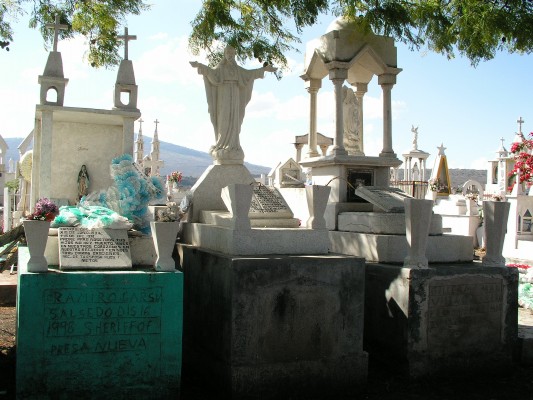Francisco Rafael Arellano-Felix, of the notorious family that ran (terrorized) the Tijuana drug plaza for about a decade, was shot to death the other day in Los Cabos by a man dressed as clown.

Never met the guy, but I once wrote about him.
Francisco Javier actually stole the queen of Mazatlan’s carnival once, and forced her into matrimony — this in 1990.
Her name was Rocio del Carmen Lizarraga. This was before his family was a household name in Mexico, but was well known for the wrong reasons in its native Mazatlan.
In 1990, Francisco Arellano Felix was owner of Frankie Oh’s – a crass discoteque built with a Flintstones prehistoric decor of large stucco boulders along Mazatlan’s beachfront drive. He was known to be anxious to enter the city’s high society. He was a friend of the great Mexican middle-weight, Julio Cesar Chavez.
That February, Rocio del Carmen Lizarraga was selected Queen of Carnival, one of the most high-profile positions in Mazatlan. She was 17, a fresh-faced high school student from a middle-class family.
A few months later, a small article appeared in the newspaper reporting that Rocio del Carmen had disappeared. Not only that, but that possibly she had been stolen by Francisco Arellano Felix. The newspaper said that her family was distraught, feared for her safety and hired private detectives to search for her.
Mazatlan spun with rumors. But though the reigning Queen of Carnival had apparently been stolen by a member of one of the state’s most notorious drug-running families, newspapers published only occasional short stories below the fold.
There were reports the couple was in Guadalajara, that they had married in a church. (Turned out that the bishop in the area refused to marry them, and they had to resort to a minor priest to perform the service.)
Finally, Rocio del Carmen’s mother, Oliva Lizarraga, told reporters she had spoken with Arellano Felix, who had not let her speak with her daughter, since “she was showering.”
The mother said her daughter, and her now-jilted fiancee, Oscar Coppel, from one of Mazatlan’s wealthiest families, were “victims of destiny” and that “God was the only one who can put things in their place.”
wealthiest families, were “victims of destiny” and that “God was the only one who can put things in their place.”
It was all very surreal.
Finally, the episode concluded when Rocio del Carmen took out a large newspaper ad with a short letter that is both thoroughly bizarre and a beautiful exposition of Mexican fatalism.
She was in Mazatlan, she wrote. She thanked people for their support, but added, “I don’t want to be asked by anyone because it would be embarrassing to have to say whether I left of my own will or was taken by force.
“I don’t want to judge the father of my children and he who gave me his last name, since he’s never mistreated me. I accept with resignation the path that destiny has prepared for me, and if God has put me on this road, I have to continue.”
She signed the ad, “Your friend, Rocio del Carmen Lizarraga de Arellano.”
And with that the episode ended, as quietly as it began.
About the worst that came down were pronouncements from Mazatlan’s high society. Arellano Felix “will never be accepted by the Mazatlan society that he wanted to enter,” Ernesto Coppel, owner of one of the city’s largest hotels, father of a Senorita Sinaloa and uncle of Rocio del Carmen’s ex-fiancee, said at the time.
 Today, the AF cartel is nothing like what it once was. One other AF brother, the feared Ramon, was killed in 2002. Three others are in US prisons. And so the death of this Arellano Felix is more about history than anything else.
Today, the AF cartel is nothing like what it once was. One other AF brother, the feared Ramon, was killed in 2002. Three others are in US prisons. And so the death of this Arellano Felix is more about history than anything else.
Indeed, the story of how he took a wife was just one in a rich history between Mazatlan’s Queen of Carnaval and narcos from Sinaloa, the birthplace of Mexican drug running.
Btw, later this video circulated on Youtube of the shooting, with the clown briefly visible dressed in blue.
Photos: Francisco Rafael Arellano Felix, Arellano Felix family; wanted poster for Arellano Felix brothers (Benjamin, now imprisoned, and Ramon, deceased) and key members of their organization.









